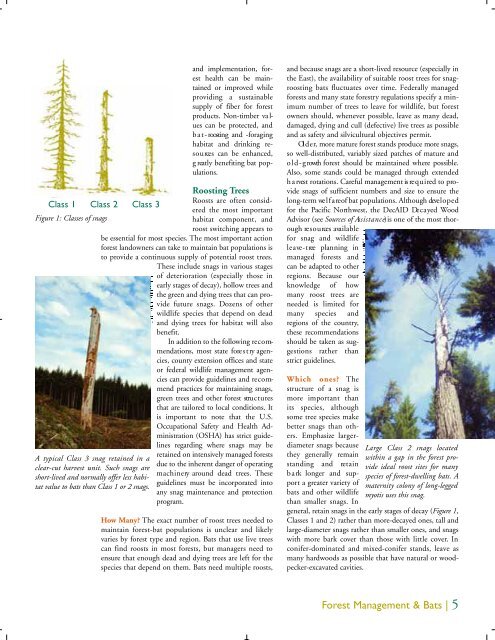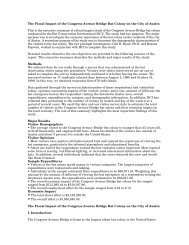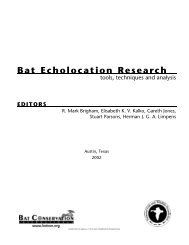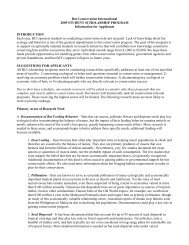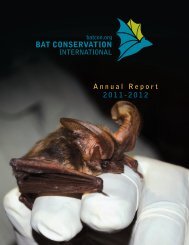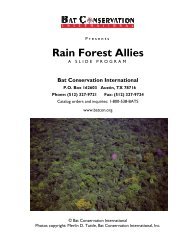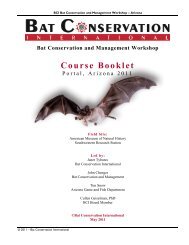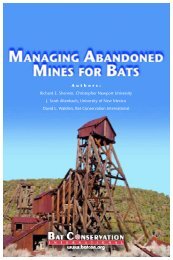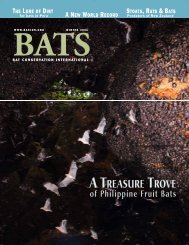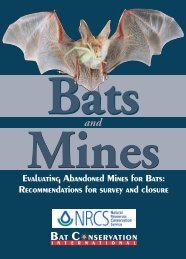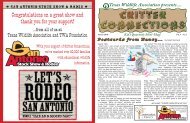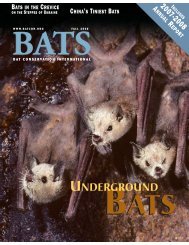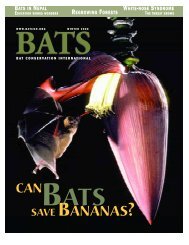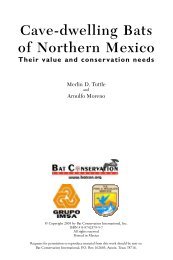Forest Management & Bats - Bat Conservation International
Forest Management & Bats - Bat Conservation International
Forest Management & Bats - Bat Conservation International
Create successful ePaper yourself
Turn your PDF publications into a flip-book with our unique Google optimized e-Paper software.
and implementation, forest<br />
health can be maintained<br />
or improved while<br />
p roviding a sustainable<br />
supply of fiber for fore s t<br />
p roducts. Non-timber va l-<br />
ues can be protected, and<br />
b a t - roosting and -foraging<br />
habitat and drinking res<br />
o u rces can be enhanced,<br />
g reatly benefiting bat popu<br />
l a t i o n s .<br />
Roosting Trees<br />
Roosts are often considered<br />
the most important<br />
habitat component, and<br />
roost switching appears to<br />
be essential for most species. The most important action<br />
forest landowners can take to maintain bat populations is<br />
to provide a continuous supply of potential roost trees.<br />
These include snags in various stages<br />
of deterioration (especially those in<br />
early stages of decay), hollow trees and<br />
the green and dying trees that can provide<br />
future snags. Dozens of other<br />
wildlife species that depend on dead<br />
and dying trees for habitat will also<br />
benefit.<br />
In addition to the following re c o m-<br />
mendations, most state fore s t ry agencies,<br />
county extension offices and state<br />
or federal wildlife management agencies<br />
can provide guidelines and re c o m-<br />
mend practices for maintaining snags,<br />
g reen trees and other forest stru c t u re s<br />
that are tailored to local conditions. It<br />
is important to note that the U.S.<br />
Occupational Safety and Health Administration<br />
(OSHA) has strict guidelines<br />
re g a rding where snags may be<br />
Class 1 Class 2 Class 3<br />
Figure 1: Classes of snags<br />
A typical Class 3 snag retained in a<br />
clear-cut harvest unit. Such snags are<br />
short-lived and normally offer less habitat<br />
value to bats than Class 1 or 2 snags.<br />
retained on intensively managed fore s t s<br />
due to the inherent danger of operating<br />
m a c h i n e ry around dead trees. T h e s e<br />
guidelines must be incorporated into<br />
any snag maintenance and pro t e c t i o n<br />
p ro g r a m .<br />
How Many? The exact number of roost trees needed to<br />
maintain forest-bat populations is unclear and likely<br />
varies by forest type and region. <strong><strong>Bat</strong>s</strong> that use live trees<br />
can find roosts in most forests, but managers need to<br />
ensure that enough dead and dying trees are left for the<br />
species that depend on them. <strong><strong>Bat</strong>s</strong> need multiple roosts,<br />
and because snags are a short-lived resource (especially in<br />
the East), the availability of suitable roost trees for snagroosting<br />
bats fluctuates over time. Federally managed<br />
forests and many state forestry regulations specify a minimum<br />
number of trees to leave for wildlife, but forest<br />
owners should, whenever possible, leave as many dead,<br />
damaged, dying and cull (defective) live trees as possible<br />
and as safety and silvicultural objectives permit.<br />
Ol d e r, more mature forest stands produce more snags,<br />
so well-distributed, variably sized patches of mature and<br />
o l d - g rowth forest should be maintained where possible.<br />
Also, some stands could be managed through extended<br />
h a rvest rotations. Careful management is re q u i red to provide<br />
snags of sufficient numbers and size to ensure the<br />
long-term we l f a reof bat populations. Although deve l o p e d<br />
for the Pacific No rt h west, the DecAID De c a yed Wo o d<br />
Advisor (see S o u rces of As s i s t a n c e)is one of the most thorough<br />
re s o u rces ava i l a b l e<br />
for snag and wildlife<br />
l e a ve - t ree planning in<br />
managed forests and<br />
can be adapted to other<br />
regions. Because our<br />
k n owledge of how<br />
many roost trees are<br />
needed is limited for<br />
many species and<br />
regions of the country,<br />
these re c o m m e n d a t i o n s<br />
should be taken as suggestions<br />
rather than<br />
strict guidelines.<br />
Which ones? T h e<br />
structure of a snag is<br />
m o re important than<br />
its species, although<br />
some tree species make<br />
better snags than others.<br />
Emphasize largerdiameter<br />
snags because<br />
they generally re m a i n<br />
standing and re t a i n<br />
b a rk longer and support<br />
a greater variety of<br />
bats and other wildlife<br />
than smaller snags. In<br />
Large Class 2 snags located<br />
within a gap in the forest provide<br />
ideal roost sites for many<br />
species of forest-dwelling bats. A<br />
maternity colony of long-legged<br />
myotis uses this snag.<br />
general, retain snags in the early stages of decay (Figure 1,<br />
Classes 1 and 2) rather than more-decayed ones, tall and<br />
large-diameter snags rather than smaller ones, and snags<br />
with more bark cover than those with little cover. In<br />
conifer-dominated and mixed-conifer stands, leave as<br />
many hardwoods as possible that have natural or woodpecker-excavated<br />
cavities.<br />
<strong>Forest</strong> <strong>Management</strong> & <strong><strong>Bat</strong>s</strong> | 5


